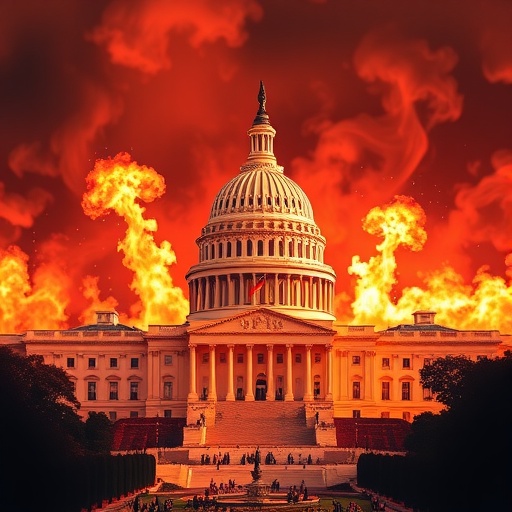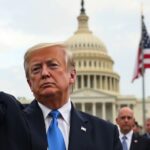Government shutdown Crisis: Trump’s Billions Freeze Ignites Constitutional Clash with Congress
In a move that’s sending shockwaves through Washington and beyond, President Donald Trump’s decision to freeze billions in federal funds amid the ongoing Government shutdown that kicked off on October 1st is being decried as a direct assault on Congress’s sacred “power of the purse.” As lawmakers from both parties huddle in deadlocked negotiations, Trump’s unilateral shifts in federal spending priorities are raising alarms of a brewing constitutional crisis, with critics arguing he’s effectively sidelining the legislative branch in a power grab that could reshape American governance.
The shutdown, now stretching into its third week, stems from a bitter impasse over border security funding, but Trump’s latest actions—impounding funds allocated for everything from infrastructure to social programs—have escalated the standoff into uncharted territory. Legal experts warn that this isn’t just political brinkmanship; it’s a potential violation of the Constitution’s Article I, which vests Congress with exclusive authority over appropriations. “This is Trump treating the federal budget like his personal checkbook,” fumed Senate Minority Leader Chuck Schumer in a fiery floor speech yesterday, capturing the raw frustration echoing across Capitol Hill.
Shutdown Ignites Over Border Wall Impasse
The Government shutdown didn’t happen overnight; it’s the culmination of months of escalating tensions between Trump and Congress on federal spending. It all traces back to the contentious issue of funding for Trump’s signature border wall along the U.S.-Mexico frontier. Republicans, led by the president, demanded $5 billion for wall construction as part of a broader spending bill to keep the government running past the September 30th deadline. Democrats, viewing it as an unnecessary and divisive expense, refused to budge, insisting on a clean continuing resolution without what they call a “vanity project.”
By October 1st, with no deal in sight, non-essential federal operations ground to a halt—affecting over 800,000 federal workers who are either furloughed or working without pay. The economic ripple effects are already staggering: the Congressional Budget Office estimates daily losses of $160 million in GDP, while small businesses near national parks and monuments report revenue drops of up to 90%. “Families are hurting, and this shutdown is hitting them where it counts—in their paychecks and daily lives,” said House Speaker Nancy Pelosi during a press conference on October 10th, her voice laced with urgency as she rallied Democrats to hold the line.
Behind the scenes, negotiations have been fraught. Trump, leveraging his Twitter platform, has repeatedly blasted Democrats for what he calls “obstructionism,” tweeting on October 5th: “Democrats want open borders—I’m fighting for American safety! No wall, no deal.” This rhetoric has only deepened the divide, with Senate Majority Leader Mitch McConnell struggling to corral GOP votes for compromise measures. A proposed bipartisan bill that would allocate $1.6 billion for border security tech instead of physical barriers was shot down last week, 48-52, along party lines. As the deadlock persists, the constitutional crisis looms larger, with Trump’s impatience boiling over into executive overreach.
Trump’s Bold Fund Freezes: A Presidential Power Play
At the heart of the escalating drama is Trump‘s aggressive use of executive authority to freeze and redirect billions in federal spending. On October 8th, the White House announced the impoundment of $12 billion from previously approved congressional appropriations, including funds for the Department of Transportation’s highway repairs and the Environmental Protection Agency’s clean water initiatives. In a stunning twist, Trump invoked the Impoundment Control Act of 1974—ironically passed to curb presidential overreach—as justification, claiming the funds were being “temporarily deferred” to prioritize national security.
This isn’t mere paperwork shuffling; it’s a seismic shift. Sources inside the Office of Management and Budget reveal that at least $3 billion earmarked for veterans’ healthcare has been paused, while another $4 billion from disaster relief pots is being eyed for border enforcement. “The president has the authority to manage execution of the budget, but freezing congressionally mandated funds crosses a red line,” explained constitutional scholar Laurence Tribe in an op-ed for The New York Times. Tribe’s words underscore the gravity: under the Constitution, Congress holds the purse strings, and any attempt by the executive to withhold funds without legislative approval echoes the scandals of the Nixon era.
Trump defended his actions during a Rose Garden presser on October 12th, stating, “I’m not usurping anything—I’m protecting America from waste and Democrat games. Congress had their chance; now it’s time to get serious about the wall.” But the freeze has immediate consequences. In California, wildfire recovery efforts are stalled without federal matching funds, leaving communities in limbo. Economists at the Brookings Institution project that prolonged impoundments could add $50 billion to the national debt through inefficiency and lost productivity, amplifying the government shutdown‘s toll.
- Key Frozen Funds: $5B Infrastructure, $3B Veterans Affairs, $2B Education Grants, $2B Disaster Aid
- Legal Precedent: 1974 Impoundment Act limits presidential deferrals to 45 days, after which Congress must approve
- Trump’s Rationale: National emergency declaration ties spending to border security
Critics, including a coalition of 150 House Democrats, have filed a resolution condemning the moves as unconstitutional, setting the stage for courtroom showdowns that could reach the Supreme Court.
Congressional Fury Erupts: Accusations of Overreach
Congress is pushing back hard against what many see as Trump‘s encroachment on their turf, framing the fund freezes as the spark for a full-blown constitutional crisis. Bipartisan outrage has united unlikely allies: even some Republicans, like retiring Rep. Paul Mitchell of Michigan, have broken ranks, calling the actions “a dangerous precedent that weakens the separation of powers.” In a rare show of unity, the House voted 235-184 on October 15th to demand the release of impounded funds, though the measure is symbolic without Senate support.
Legal challenges are mounting swiftly. The American Civil Liberties Union announced plans to sue the administration on behalf of affected federal employees, arguing that the freezes violate the Antideficiency Act, which prohibits spending beyond appropriations—or withholding them arbitrarily. “This isn’t governance; it’s governance by fiat,” ACLU attorney Lee Gelernt told CNN, highlighting how the government shutdown has exposed deep fissures in federal spending oversight.
Inside the Capitol, whispers of impeachment are growing louder. Progressive Democrats like Rep. Alexandria Ocasio-Cortez have tweeted, “Trump’s power grab during this shutdown is impeachable—Congress must act to reclaim our authority.” Meanwhile, McConnell faces pressure from his caucus to negotiate an end to the stalemate, with polls showing 62% of Americans blaming both parties equally for the chaos (Pew Research, October 14th). A group of moderate senators, including Susan Collins and Lisa Murkowski, proposed a “grand bargain” last week—$2 billion for the wall in exchange for Dreamer protections—but Trump rejected it outright, tweeting it was “fake news compromise.”
The human stories add emotional weight. Federal worker Maria Gonzalez, a furloughed Smithsonian curator from Virginia, shared her plight in a viral Washington Post interview: “I’m missing mortgage payments because of this political fight. How is freezing funds helping anyone?” Such narratives are fueling public pressure, with #EndTheShutdown trending nationwide and protests swelling outside the White House.
Economic Fallout Deepens: Billions in Jeopardy
The government shutdown and subsequent fund freezes are exacting a heavy economic price, threatening livelihoods and stability across the nation. With federal spending in limbo, sectors from travel to tech are reeling. The U.S. Travel Association reports a $1.2 billion loss in tourism revenue alone since October 1st, as national landmarks like the Grand Canyon remain shuttered. In the financial markets, the Dow Jones dipped 300 points on October 11th following news of the impoundments, with investors fretting over fiscal uncertainty.
Delving deeper, the freezes disproportionately hit vulnerable programs. The Department of Housing and Urban Development has halted $800 million in rental assistance, potentially displacing 50,000 low-income families, according to HUD estimates. Agriculture, a GOP stronghold, isn’t spared: $1.5 billion in farm subsidies are deferred, prompting outcry from Midwestern lawmakers. “This shutdown is killing rural America,” said Sen. Chuck Grassley (R-IA) in a statement, revealing cracks in Trump’s base.
Broader stats paint a dire picture. The shutdown marks the third-longest in U.S. history, surpassing the 1995-96 Gingrich-era standoff. Moody’s Analytics forecasts a 0.3% GDP shave if it drags into November, with unemployment ticking up 0.2% among federal contractors. Small business owners, like those in the D.C. area, are hardest hit: a National Federation of Independent Business survey found 40% have laid off staff due to delayed payments. “We’re talking real people, real jobs vanishing because of this constitutional crisis,” economist Mark Zandi remarked to Bloomberg.
- Tourism Hit: 2 million fewer visitors to federal sites, $1.2B lost
- Contractor Delays: $10B in payments backlog, affecting 1 million workers
- Long-Term Risk: Credit rating agencies watching closely; potential downgrade if unresolved
Amid the chaos, innovative workarounds emerge—states like California are fronting funds for national parks—but these band-aids can’t stem the tide of a prolonged government shutdown.
Path Forward: Resolving the Standoff and Averting Disaster
As the government shutdown grinds on, eyes are turning to potential off-ramps that could defuse the constitutional crisis and restore federal spending normalcy. Bipartisan talks, mediated by Vice President Mike Pence, are slated for October 18th, focusing on a short-term funding bill that decouples the wall debate from must-pass appropriations. Trump has hinted at flexibility, telling Fox News, “If Democrats come to the table with real border security, we can end this fast—but no more games.”
Yet challenges abound. Legal experts predict court battles over the fund freezes could drag into 2020, with the Supreme Court possibly weighing in on presidential impoundment powers—a ruling that could either empower future executives or reinforce congressional primacy. On Capitol Hill, momentum builds for budget process reforms, including automatic continuing resolutions to prevent future shutdowns, as proposed in a bill by Sens. Lindsey Graham and Cory Booker.
Looking ahead, the stakes are sky-high. A prolonged impasse risks eroding public trust in institutions, with Gallup polls showing confidence in government at a 20-year low of 28%. Economically, the Federal Reserve warns of inflationary pressures if spending shifts disrupt supply chains. For everyday Americans, the human cost mounts: food banks report a 25% uptick in demand from furloughed workers, and holiday travel plans hang in the balance with TSA staffing shortages.
In this high-stakes poker game between Trump and Congress, the next few days could determine not just the fate of billions in federal spending, but the very balance of power in Washington. As negotiations intensify, one thing is clear: resolving this government shutdown will require compromise, or the constitutional crisis may deepen, leaving lasting scars on the nation’s governance.









